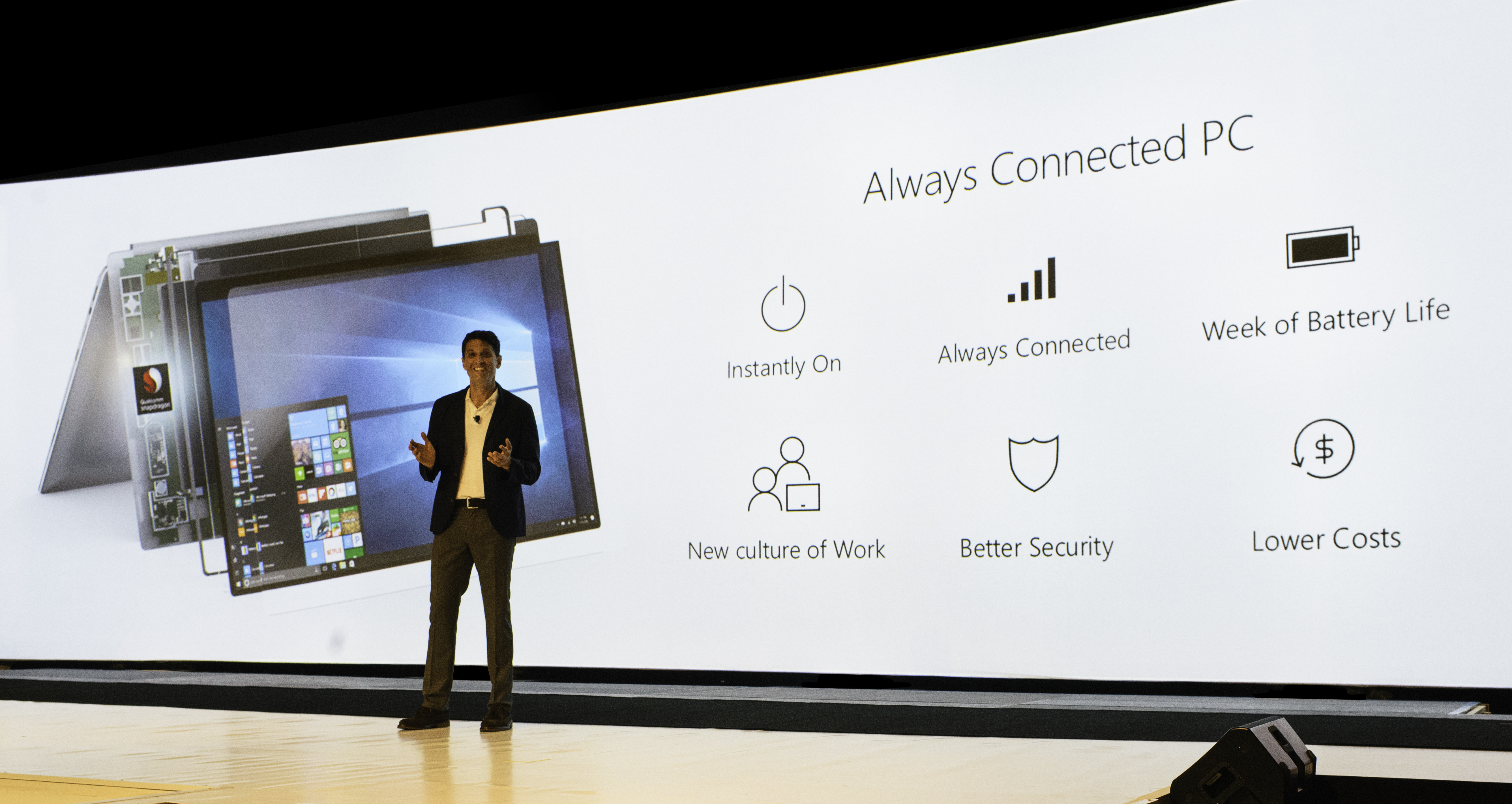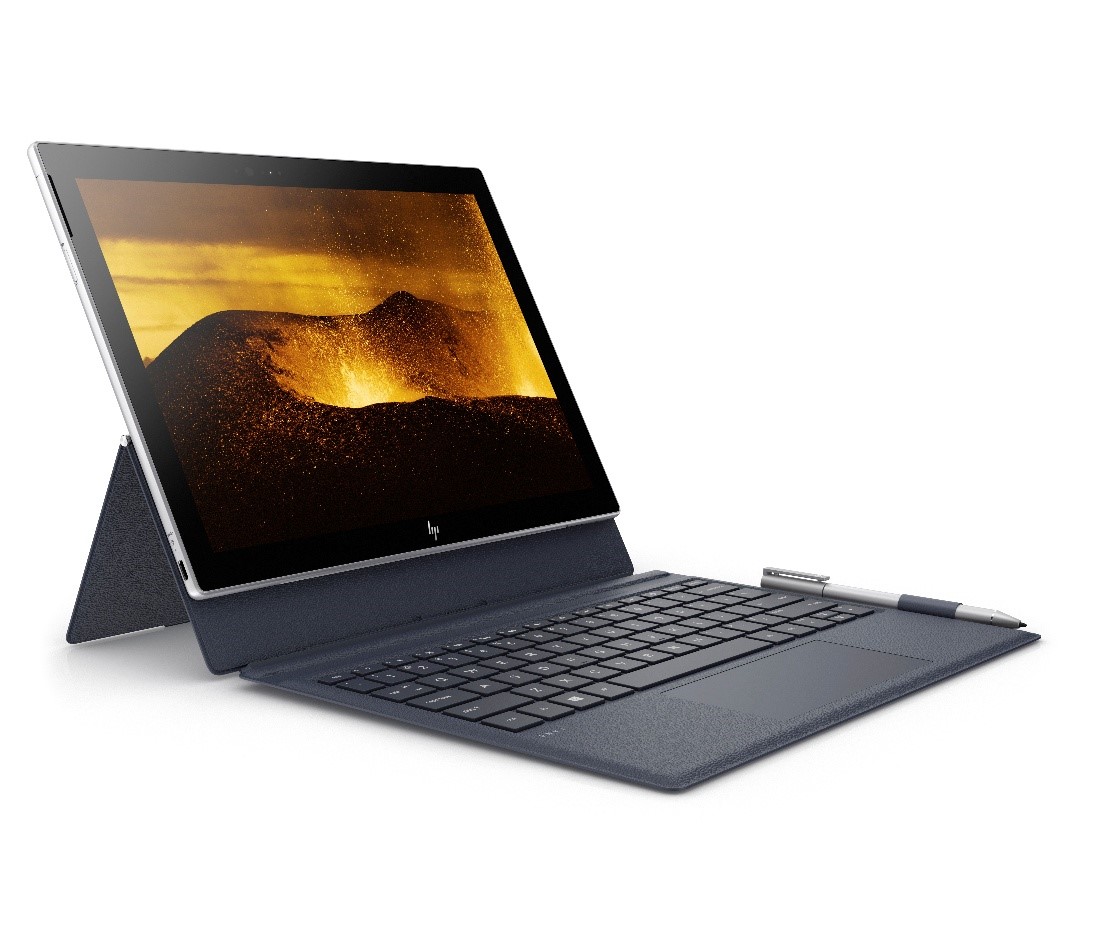Always Connected PCs enable a new culture of work
New devices from HP and ASUS are instantly on, always connected with incredible battery life

New Always Connected PCs unveiled
Last year at this time, I was with many of our hardware partners at the WinHEC event in Shenzhen, China, where we painted a new vision for connected computing with built-in LTE connectivity, devices that are instantly on and battery life that went beyond hours into days and weeks. We also set a goal for us to begin delivering on this promise within one year.
Today, at the Qualcomm Snapdragon Tech Summit, I stood with Cristiano Amon, President of Qualcomm Chips, and we delivered on the promise that we made then. Along with our hardware partners HP and ASUS, we showed the world the first full-featured Always Connected PCs on the Qualcomm Snapdragon chipset running Windows 10 and a new, optimized version of Office 365. ASUS and HP have worked hand in hand with us to deliver on pushing the boundaries of what a PC can do, and we continue to work closely with Lenovo as they build their own Always Connected PC.


Instantly on, Always Connected, and a week of battery life is liberating
One of the favorite parts of my job is trying out new products. Seeing the innovation, understanding how all the components work together, how it looks and feels, and ultimately how the customer will experience the product.
For the last few months, I have been using an Always Connected PC, running on Qualcomm’s Snapdragon platform. In the last week, I watched the movie Moana with my daughter, worked in PowerPoint, browsed the web every day, reviewed budgets in Excel, checked email while waiting to pick up my son from soccer, marked up a few PDFs with Ink, played some games on the plane – all of this without plugging in my power cord all week.
The PC is fast and responsive when I am using it and quickly goes into standby being incredibly battery efficient when I’m not using it.
This new Always Connected PC is ultrathin, beautifully designed, running Windows 10 and a new, optimized version of Office 365. But beyond the full experiences you’d expect in a PC, this new Always Connected PC has fundamentally transformed how I work, because of three significant advantages over my other PCs.
- The screen is instantly on whenever I pick up the device. I never have to wait for it to wake up, it’s just on.
- Being always connected wherever I am whether I am in the car, airport or coffee shop, always being connected just feels like the most natural, safe and secure way to work with teams and be creative.
- Lastly, the battery life is just awesome! I am finding myself charging it once a week. When I was using a wearable that needed to charge every day, I didn’t really rely on it. Once I moved to a Fitbit that only needed charging once a week that was game changing for me. Not carrying around power cords is liberating.
Once you start using this new category of PCs that are instantly on, always connected with a week of battery life and the full Windows 10 experience, you can really feel what a big shift this will be for consumers.
Always Connected PCs enable a new culture of work with better security at a lower cost
Always Connected PCs also have three huge benefits for organizations
- New culture of work: IT is always thinking about the culture of work they enable through the technology they choose: how a given device enables teams to collaborate and be productive. The Always Connected PC is a cultural shift, enabling teams to work effectively, whether they are on a corporate campus, visiting customers or on the bus commuting, freeing a real constraint on the creativity of employees today.
- Better security: IT also must manage increasing security threats and is responsible for protecting an organization’s information. Security has been a huge focus for Windows 10. But there are still these public Wi-Fi hotspots out there, which every day unknowing users connect to and could put hackers in control of the data coming and going to their device, potentially enabling hackers to steal corporate data and invade user privacy. The Always Connected PC is real security progress enabling safe connectivity everywhere, bypassing untrusted networks.
- Lower costs: Today IT organizations are spending millions of dollars installing, updating and maintaining Wi-Fi antennas and repeaters throughout their buildings, and upgrading those every few years to make them even faster. At the same time, mobile operators have invested billions in building fast 4G networks. The United States alone is now 98% covered by 4G. And mobile operators have now embarked on even faster 5G network build outs that will be even faster.
Just like IT is now leveraging the massive investments in cloud compute and storage in data centers like Microsoft Azure, moving networking to the cloud will lower IT costs. Today’s global mobile operators are professionally maintaining, managing and updating their networks with massive investments in speed and security. Always Connected PCs are key for IT leaders to unlock the benefits of this global networking and provide employees with a modern workplace they want at a lower cost.
With the introduction of the Always Connected PC, IT now must ask themselves: how can they leverage the public networks of Sprint, AT&T, Orange, and others – and reduce their investment in their private antennas – to give employees faster connectivity at a lower cost than they enjoy today?
For IT, the Always Connected PC enables a new culture of work, a real step forward in security and an opportunity for massive cost savings, as the local network moves to the cloud. More on this shift is detailed in Accelerating the Move to the Cloud with Always Connected Computing.
Always Connected PCs are modern Windows 10 devices with Windows Hello, touch, pen and Ink, with thin, light, elegant designs that are more secure, instantly on, always connected with a week of battery life. When I think about organizations and whether they are going to leverage the massive networks of mobile operators and adopt these new PCs – the answer is simple: It is not a matter of if, it’s a matter of when and how fast all mobile PCs become Always Connected PCs.
Terry

